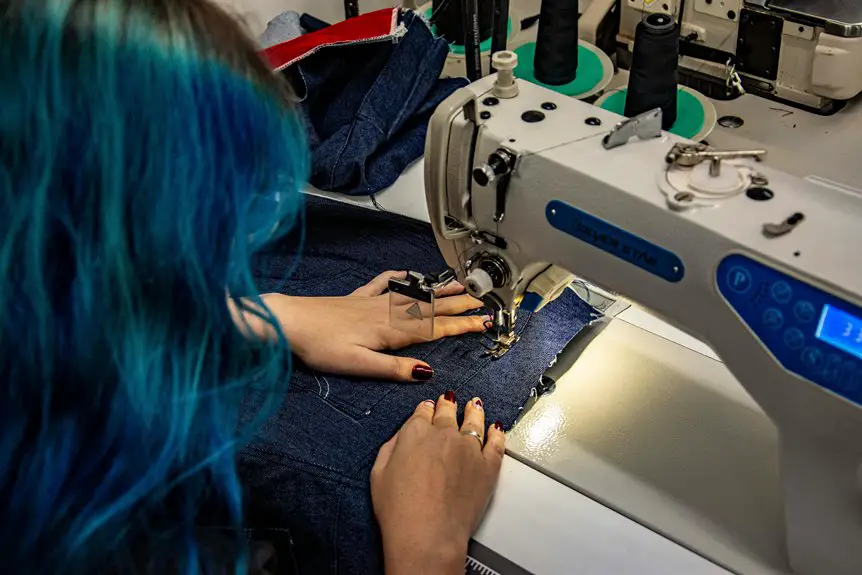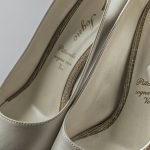You’ll find gabardine and denim differ mainly in weave and purpose. Gabardine is tightly woven with a smooth, polished finish, making it great for formal wear, while denim’s chunkier twill weave offers rugged durability ideal for casual or work clothes. Gabardine often uses wool or synthetics for strength and wrinkle resistance, whereas denim is mostly cotton for breathability and toughness. If you want to know how these fabrics affect care, costs, and style, keep exploring.
Table of Contents
Key Takeaways
- Gabardine is a tightly woven, smooth twill fabric with a refined, matte finish, while denim has a coarser, rugged texture with visible weave patterns.
- Gabardine is made from wool, cotton, or synthetics and is wrinkle-resistant; denim is primarily 100% cotton, focusing on breathability and durability.
- Denim is heavier and more durable for casual or workwear, whereas gabardine offers a polished look suited for formal clothing.
- Gabardine requires gentle washing and air drying to maintain shape; denim should be washed sparingly and dried inside out to prevent fading.
- Denim is generally more affordable and widely available, while gabardine tends to be pricier and less common in local stores.
Origin and History of Gabardine and Denim
Although gabardine and denim are both durable fabrics, they come from very different origins.
Gabardine and denim share durability but originate from distinct histories and purposes.
When you think of gabardine, picture 19th-century England, where Thomas Burberry invented it to create weatherproof clothing. This tightly woven fabric was designed to keep you dry and comfortable in harsh climates.
On the other hand, denim has roots in 17th-century Europe but became famously associated with American workers and miners in the 1800s. If you wear denim, you’re tapping into a history linked to rugged workwear and casual style.
While gabardine started as a practical fabric for protection, denim evolved into a symbol of durability and rebellion.
Understanding these backgrounds helps you appreciate why each fabric carries its unique character and purpose.
Weave Patterns and Fabric Construction
When you look at gabardine and denim, their twill weave stands out as a key feature shaping their durability and texture.
You’ll notice gabardine’s tighter fabric density gives it a smoother, more refined finish compared to denim’s chunkier, rugged feel.
Understanding these differences helps you choose the right fabric for your project or style.
Twill Weave Characteristics
Since twill weave forms the foundation of both gabardine and denim, understanding its characteristics helps you appreciate the unique qualities of each fabric.
Twill weave creates a distinctive diagonal rib pattern by passing the weft thread over one or more warp threads, then under two or more warp threads in a repeating sequence. This structure gives the fabric strength, durability, and a bit of stretch.
When you examine gabardine, you’ll notice a tight, smooth twill with fine diagonal lines that run sharply across the surface.
Denim, on the other hand, features a more pronounced, rugged twill with a visible diagonal texture. The direction and steepness of the twill angle also vary, influencing how each fabric drapes and wears over time.
Fabric Density Differences
Because fabric density plays an essential role in the feel and durability of gabardine and denim, you’ll want to understand how their weave patterns and construction differ.
Gabardine uses a tightly woven twill weave, creating a smooth, dense fabric that feels firm yet flexible. Denim’s twill weave is looser, giving it a chunkier texture with more breathability.
Here’s how their fabric density contrasts:
- Gabardine’s threads are packed closely, making it heavier and less porous.
- Denim’s weave spaces threads wider, allowing for more airflow.
- The tighter gabardine weave gives it a crisp finish and wrinkle resistance.
- Denim’s looser density creates a rugged, durable fabric with natural stretch.
Understanding these differences helps you pick the right fabric for your needs.
Fiber Content and Material Composition
Although both gabardine and denim are popular fabrics, their fiber content and material composition set them apart considerably.
Gabardine is typically made from tightly woven wool, cotton, or synthetic fibers like polyester, giving it a smooth and durable finish. It often features a blend to enhance wrinkle resistance and strength.
Denim, on the other hand, primarily consists of 100% cotton or cotton blends with a small percentage of elastane for stretch. This cotton-heavy makeup gives denim its characteristic breathability and toughness.
You’ll notice that gabardine’s blend focuses more on a polished, structured feel, while denim emphasizes comfort and flexibility due to its cotton base.
Understanding these differences helps you pick the right fabric for your specific needs, whether it’s formal wear or casual, rugged clothing.
Texture and Appearance Differences
When you look closely at gabardine and denim, their textures and appearances reveal distinct personalities. Gabardine feels smooth and tightly woven, giving it a sleek, polished look.
Denim, on the other hand, is coarser with a visible weave pattern, offering a rugged, casual vibe. Here’s how they differ:
- Gabardine has a twill weave with fine diagonal ribs, creating a smooth surface.
- Denim’s twill weave is more pronounced, showing white and blue threads.
- Gabardine often appears matte and refined, ideal for formal wear.
- Denim shows texture with visible stitching and fades, perfect for casual styles.
You’ll notice gabardine’s sleekness contrasts Denim’s rougher, lived-in charm at first glance.
Durability and Strength Comparison
The differences in texture and appearance between gabardine and denim also reflect how each fabric holds up over time.
When you choose denim, you’re getting a rugged, heavyweight fabric built to endure heavy wear and tear, making it ideal for workwear and casual clothing that faces frequent abrasion.
Gabardine, on the other hand, is tightly woven and smooth, offering impressive strength but with a lighter, more refined feel. While it resists wrinkling and maintains its shape well, gabardine isn’t as tough against rough use as denim.
So, if durability and toughness are your top priorities for long-lasting, hard-wearing garments, denim stands out.
But if you want strong fabric with a sleeker look, gabardine’s strength won’t disappoint either.
Breathability and Comfort Factors
Since comfort plays an essential role in choosing fabric, you’ll want to reflect on how gabardine and denim perform in breathability and wearability.
Gabardine, with its tight weave, offers a smooth feel but limits airflow, making it less breathable. Denim, on the other hand, is thicker but has a looser weave, allowing better ventilation over time.
Consider these factors:
- Gabardine feels lighter initially but traps heat.
- Denim softens with wear, increasing comfort.
- If you prefer cooler fabrics, denim’s breathability suits you better.
- For a crisp, polished look, gabardine offers comfort in moderate climates.
Understanding these differences helps you pick the fabric that keeps you comfortable throughout your day.
Common Uses in Fashion and Workwear
Although gabardine and denim share durability, they serve different roles in fashion and workwear.
You’ll find gabardine commonly used in tailored clothing like suits, trousers, and trench coats because of its smooth finish and elegant drape. It’s perfect when you want a polished, professional look.
Denim, on the other hand, dominates casual wear—think jeans, jackets, and overalls—thanks to its rugged texture and ability to withstand heavy use. If you need workwear that’s tough and practical, denim’s your go-to fabric.
Gabardine suits formal or semi-formal occasions, while denim fits laid-back styles and manual labor settings.
Care and Maintenance Tips for Each Fabric
To keep your gabardine and denim looking their best, you’ll want to follow specific washing guidelines that suit each fabric’s texture.
Pay attention to drying techniques to prevent damage or shrinkage, and store them properly to maintain their shape and quality.
Let’s explore how these simple steps can extend the life of both fabrics.
Washing Guidelines
When you care for gabardine and denim properly, you’ll extend their lifespan and keep them looking sharp. Each fabric has unique washing needs to maintain its texture and color. Here’s how to handle them:
- Wash gabardine in cold water on a gentle cycle to prevent shrinking and maintain its smooth finish.
- Turn denim inside out before washing to protect the dye and reduce fading.
- Use mild detergent for both fabrics to avoid harsh chemicals that can damage fibers.
- Avoid over-washing denim; wash only when necessary to preserve its rugged look and strength.
Following these simple steps will keep your gabardine crisp and your denim durable, ensuring both fabrics stay in great shape.
Drying Techniques
After washing gabardine and denim with care, how you dry them plays a big role in maintaining their quality.
For gabardine, avoid high heat that can shrink or damage its tight weave. Instead, lay it flat or hang it to air dry in a shaded area, which helps preserve its smooth finish and shape.
Denim, on the other hand, is more durable but still benefits from gentle drying. Turn your denim inside out and hang it to dry naturally to prevent fading and stiffness.
If you must use a dryer, opt for a low heat setting and remove denim while slightly damp to reduce wrinkles.
Following these drying techniques keeps both fabrics looking sharp and lasting longer.
Storage Recommendations
Proper storage plays an essential role in keeping your gabardine and denim garments in top condition. To maintain gabardine’s smooth finish, hang it on padded hangers to avoid creases.
For denim, folding is best, as hanging can stretch the fabric over time. Both fabrics benefit from storage in a cool, dry place to prevent mold and mildew. Avoid direct sunlight to protect colors from fading.
Here are four storage tips to follow:
- Use garment bags for gabardine to shield it from dust.
- Fold denim carefully to minimize wrinkles.
- Store in breathable containers to allow airflow.
- Keep both fabrics away from moisture and heat sources.
These steps will prolong your garments’ life and keep them looking fresh.
Environmental Impact and Sustainability
Although both gabardine and denim are popular fabrics, their environmental footprints differ markedly, and understanding these differences can help you make more sustainable choices.
Denim, often made from cotton, demands significant water and pesticide use during cultivation, impacting ecosystems heavily. However, many manufacturers now adopt organic cotton or recycled fibers to reduce this footprint.
Gabardine, typically woven from wool, cotton, or synthetic fibers, varies in impact depending on the source. Wool production, for example, involves land use and methane emissions, while synthetic gabardine relies on fossil fuels.
When choosing between them, consider fabric origin and production methods. Opting for certifications like organic, recycled, or responsibly sourced fibers can minimize environmental harm.
Cost and Availability in the Market
When choosing between gabardine and denim, you’ll notice a difference in price that can impact your budget.
Gabardine tends to be pricier due to its finer weave and quality, while denim is generally more affordable and widely available.
Understanding where to find each fabric and how much they cost will help you make the best choice for your needs.
Price Comparison Overview
Both gabardine and denim come with distinct price points that reflect their production processes and market demand.
You’ll notice that gabardine, known for its tight weave and smooth finish, often costs more due to its complex manufacturing. Denim, with its rugged texture and casual appeal, tends to be more affordable and widely available.
Here’s a quick price comparison to guide you:
- Gabardine typically ranges from $10 to $25 per yard.
- Denim usually costs between $5 and $15 per yard.
- Specialty gabardine fabrics, like wool blends, can push prices higher.
- Denim’s mass production keeps prices consistently lower.
Understanding these differences helps you make informed choices based on your budget and project needs.
Market Accessibility Options
Since gabardine requires more specialized production, you might find it less readily available in local stores compared to denim, which is widely stocked due to its popularity and mass production.
When shopping, you’ll notice denim is easier to find in various styles and price ranges at most retailers, from budget to high-end.
Gabardine, on the other hand, often appears in specialty or high-quality fabric stores, making it a bit harder to source. If you want gabardine, online fabric shops or tailor suppliers are your best bets.
Keep in mind, gabardine usually costs more because of its complex weaving process, so you should be prepared to invest a bit extra.
Denim’s broad availability and affordability make it a more accessible choice for everyday wear.
Frequently Asked Questions
Can Gabardine and Denim Be Blended Together in One Fabric?
Imagine two dancers blending styles seamlessly—you can blend gabardine and denim in one fabric, combining gabardine’s smoothness with denim’s ruggedness. You’ll get a versatile, durable textile perfect for unique, stylish garments you’ll love.
Which Fabric Is Better for Upholstery or Home Decor?
You’ll find gabardine better for upholstery due to its smooth, durable finish and resistance to wrinkling. Denim’s heavier, casual texture suits home decor but may wear faster with heavy use. Choose based on style and durability needs.
Are Gabardine and Denim Fabrics Hypoallergenic?
You shouldn’t expect gabardine or denim to be fully hypoallergenic since both can trap dust and irritants. However, if you’re sensitive, gabardine’s tighter weave might cause fewer reactions than denim’s rough, looser texture.
How Do Gabardine and Denim React to Dyeing Processes?
Imagine painting on smooth glass versus rough canvas. You’ll find gabardine absorbs dye evenly, giving vibrant colors, while denim’s texture soaks dye deeply, creating that iconic indigo fade you’ll love wearing over time.
Can Gabardine and Denim Fabrics Be Recycled or Upcycled Differently?
You can recycle and upcycle both fabrics, but gabardine’s smooth texture suits tailored upcycling, while denim’s ruggedness fits casual projects. Denim often gets repurposed into bags or patches more easily than gabardine.







